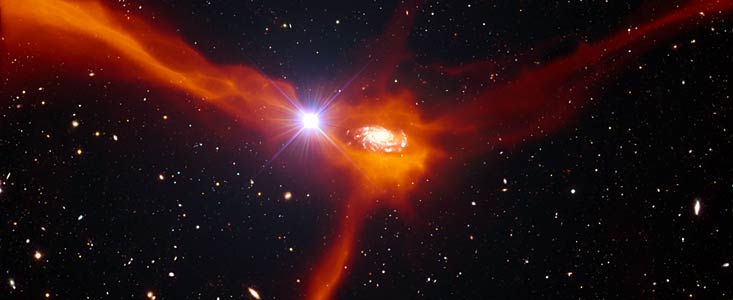"We were able to use ESO's Large Telescope to study both the interior of the galaxy itself and the gas surrounding it. This means we can attack an important problem in the galaxy formation process: how galaxies grew and fueled the star formation process." says the lead researcher

Astronomers have always suspected that the growth of galaxies was made possible by the ingestion of material from their surroundings, but the process was difficult to observe directly.
Now researchers at the "Very Large Telescope" (VLT) of ESO (European Southern Observatory) have taken advantage of rare straight-line estimates of a distant galaxy and an even more distant quasar. A quasar is the very bright center of a galaxy centered on a supermassive black hole. The light from the quasar passes through the material surrounding the galaxy in its path before reaching Earth. The one that makes it possible to study its properties in detail, including the properties of the gas surrounding the distant galaxy. This is how they observed the best example yet of a galaxy in the gobbling phase.
"This kind of straight line evaluation is very rare. The alignment allows us to make unique observations," explains Nicolas Bouche from the Research Institute for Astrophysics and Planetology (IRAP) in Toulouse, the lead researcher in the new paper.
"We were able to use ESO's Large Telescope to study both the interior of the galaxy itself and the gas surrounding it. This means we can attack an important problem in the galaxy formation process: How did the galaxies grow and fuel the star formation process?”
Galaxies quickly consume the interstellar gas reservoir as they form new stars and therefore there must be a reservoir to provide new gas for continued growth. The astronomers suspect that the answer to the problem lies in the collection of cold gas that surrounds the galaxy thanks to its gravity. In this scenario, the galaxy attracts gas that surrounds it, swirls around it, and finally falls inward. Although some evidence of the growth process has already been observed before in galaxies from that time, the motion of the gas and other properties have not been studied until now.
The researchers used two instruments SINFONI and UVES - both connected to ESO's VLT in Parnell in northern Chile. The new observations show how the galaxy itself rotates and also reveal the composition and movement of gas outside the galaxy.
"The properties of the huge volume of gas surrounding the galaxy were exactly as we expected to find in cold gas pulled by the galaxy" says Michael Murphy from Swinburne University in Australia and co-author of the paper. "The gas moved as expected, its quantity was expected and its composition also matches the models exactly. It's like lion feeding time at the zoo. This particular galaxy has a big appetite and we discovered how it feeds itself so that it grows rapidly."
Astronomers have also found evidence of the existence of material around galaxies in the early universe, but this is the first time they have been able to clearly show that the material is moving into the galaxy and not out, as well as determine the composition of the fresh fuel used to produce new generations of stars. Without the quasar light acting like a spotlight on the gas surrounding the galaxy, it would not have been discovered.
"In this case we were lucky that the quasar was in exactly the right place for its light to pass through the infalling gas. The next generation of extremely large telescopes will be able to enable studies with a large line of sight to each such galaxy and will provide a much more complete view." summarizes Crystal Martin from the University of California, Santa Barbara, another of the research partners.
